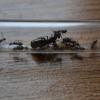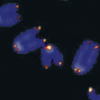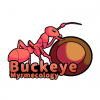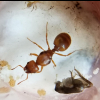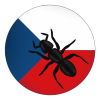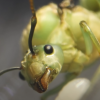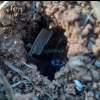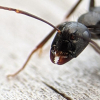Update 12 (23/05/20)
Prenolepis imparis:
These queens are doing pretty well. Two of the queens are wingless, one has shed a wing or two in the tube, and the other still has her wings. However, judging by the size of the brood pile, I'd say at least two of the queens are fertile. Take a look:


Lots of eggs, even a few small larvae. They're protective of their brood, but pretty calm. Don't run around everywhere when you disturb them (Looking at you, Formica).


Ponera pennsylvanica:
Collected a small colony of these when I was out of the city. Likely gonna trade them to someone else, too small for my tastes. Neat looking though.



Blurry queen cause my camera work kinda sucks.

Lasius umbratus-group:
Found two of these girls when I was out of the city. Introduced one to some Lasius cf. brevicornis (maybe?) workers, seems to have gone well. Currently in the process of introducing the other. Wasn't planning on really keeping any parasitic Lasius besides interjectus, but the more I look at these girls, the more I appreciate them. They're kinda like little tanks, and they're good at fighting off Lasius workers (had a few mishaps during the introduction, queen's okay, but some workers were lost). Comes with the job I guess. Anyways, this one queen's only got 10 hosts, which is a little low. Gonna see if I can collect some Lasius brood somewhere sometime, and give it to them. Problem is, all Lasius in my area don't have pupae yet, so I'm stuck with gently scooping up larvae. Not the best.


Remains of a worker. One of the unlucky ones. I didn't have my paintbrush on me when I collected these workers, so I had to scoop them into my vial using my hand, which lead to a few casualties.





Formica fusca-group:
As usual, the one colony is doing well. No brood at the moment, but all the workers look healthy and full. The other colony is still doing nothing. I suspect (and hope) these guys lay in batches. Otherwise the lack of brood in the good colony would indicate they're going the way of the bad colony, which would suck.


Myrmica sp.:
Found these guys when I was out of the city. Not gonna keep them either, but they're kinda neat - almost entirely black in color. For someone who's really only seen Myrmica rubra, these guys are kinda interesting.

And of course they've chosen to nest in the outworld. Shouldn't matter much, I'll likely be shipping them out in a few day's time anyways, so that someone else can enjoy them more than I can.
Formica wheeleri:
Probably gonna be the last update for these guys too. No new brood for over a month now, so I'm gonna go ahead and call it with them. I assume they're obligate slave raiders, and I don't have ready access to Formica brood for the majority of the year. Seeing as how my fusca-group colonies are doing, I probably won't even be able to rely on them for brood. I'll also be shipping these guys out. Hopefully they'll go to someone who can care for them better. Shouldn't be impossible to keep them, at least the workers don't drop dead if they haven't raided (unlike Polyergus iirc), so in theory if one has lots of Formica around and can raid there nests a few times a year, one could keep this colony going and even grow it larger.



Only a few Formica oreas hosts left at this point. They've turned into the colony's repletes, though they are still just as aggressive as ever.


Formica aserva:
These guys are still doing okay. Not much brood, only one large larva, but hopefully after this first batch things will get rolling again. Queen has nerves of steel and doesn't seem to mind the light, whereas the host workers grab the brood and run as soon as I so much as look at them.





Workers are plump and healthy, and the queen seems okay too. All I can do is leave them be and let them do their thing. Hopefully this colony does well, cause then I'll have locked down my sanguinea-group colony for my collection. After that, it's just exsecta-group and rufa-group to go.
Pogonomyrmex occidentalis:
These guys are exploding, and have made quite a mess.


Not even really worth it to take pictures anymore, cause the glass is so grimy. They're super aggressive too - whenever I disturb them, hordes of workers swarm into the outworld. Roaches stand no chance anymore. They're starting to chew through seeds at a rapid pace now too. Interestingly, another keeper with a queen from the same batch as this one already has queen pupae in his colony, which means this species can go from founding to alates in less than a year. Not sure if my colony is there yet, but perhaps by the end of this season or by next year they'll have alates.
Camponotus pennsylvanicus:
The drones have eclosed!



Still lots of drone brood present as well. Queens of this species should be flying literally any day now, so I'll likely be introducing a new queen to this colony in the near future. I've stopped feeding them protein in an attempt to slow down the rate of drone production, but as I said, they've still got lots of brood lying around. Not sure what I'll do about it. I guess the drone's will just pass on when they're too old. Might let them fly - after all, this colony was collected from my back deck. We'll see.
Finally, I wanted to share some pictures of a Formica cf. subintegra worker I took when I was out of the city this past week:


These were taken with my cellphone and a 10 dollar macro lens. Trick is sunlight it seems, and a lot of luck. I was super excited to find this worker's colony, and although it's a bit of a bummer that they're subintegra (obligate slave raiders like the wheeleri), it was still neat to see a sanguinea-group colony in person. It was almost entirely hosts, with only a few parasitic workers here and there. I hear that kind of colony composition is common for this species.
Anyways, that's it for this update. Hopefully next time, I'll have a queen for the Camponotus colony, and maybe even a rufa-group colony as well. We'll see.




















